
William Randell the father of Mannum and Murray River steamers
Sketches by Walter Cunningham - Text by Ian Mudie, from River Rivals - Australians in History
Hand coloured by Design Train - Mary Ann plans Mannum River Dock Museum of River History
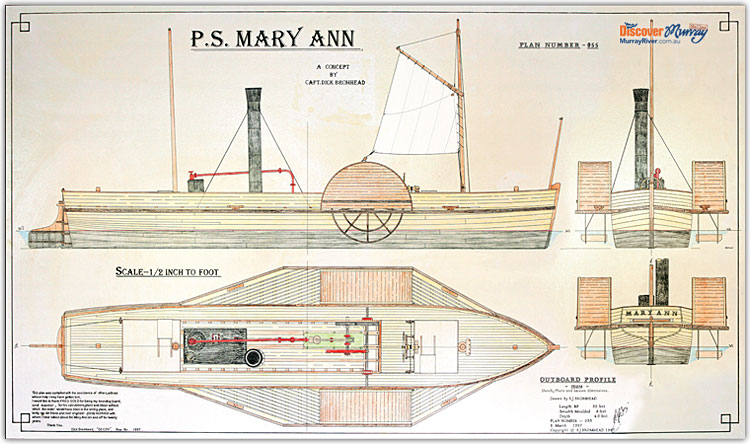
The most remarkable thing about building the Mary Ann is that William Randell
had no experience in boat building and had never before even seen a steamer.
The man and his dream
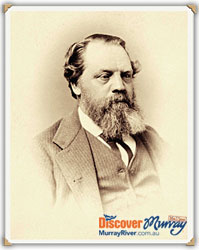 William Randell was born in England in 1824 and travelled to South Australia with his parents in 1837. By the 1840s his father had established a steam driven flour mill at Gumeracha and held pastoral leases along the Murray River. William, as the eldest son, was often sent there to herd cattle. And there began his dream of creating a steam driven paddle boat to trade on the river. William wrote that he was seized with the determination that he would be the first man to put a steam boat on the river. When the news of gold discoveries along the Goulburn, a tributary of the Murray, reached William in 1852, he decided it was time for him to turn his dream into reality and build his steam driven paddle wheeler.
William Randell was born in England in 1824 and travelled to South Australia with his parents in 1837. By the 1840s his father had established a steam driven flour mill at Gumeracha and held pastoral leases along the Murray River. William, as the eldest son, was often sent there to herd cattle. And there began his dream of creating a steam driven paddle boat to trade on the river. William wrote that he was seized with the determination that he would be the first man to put a steam boat on the river. When the news of gold discoveries along the Goulburn, a tributary of the Murray, reached William in 1852, he decided it was time for him to turn his dream into reality and build his steam driven paddle wheeler.
Building of the Mary Ann
With two carpenters to help them, the Randell brothers made a careful choice of timber from the hills around Gumeracha, using bullock-teams to drag the red-gum logs to the spot where they were to be cut into planks by pitsaw. This meant that each log was laid across the pit; then a man standing above the pit dragged at one end of a cross-cut saw, while another, who must have worked in a sweat and showers of sawdust, hauled on the other end from down below.
When the timber was cut they prefabricated the hull of the boat; this they carted in sections forty-eight kilometres across the Adelaide Hills and the Murray Flats to the river-bank, where they put it together. It has been said that they did this at the spot where Mannum now stands. William Randell, however spoke of building her at Noa-No, a few kilometres upstream from Mannum. Late in 1852, the Mary Ann was launched and the engine fitted. It was a 7 to 8 HP beam engine with 10 inch cylinders and was made by Mr Claus Gehlken, a German engineer at Hindmarsh. The boiler, the only surviving relic of the Mary Ann, was oblong in shape and proved to be very dangerous. It had to be reinforced with chains and wedges to avoid it blowing apart. The brothers made their first trip on February 19, 1853.
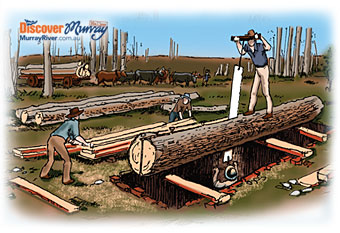 |
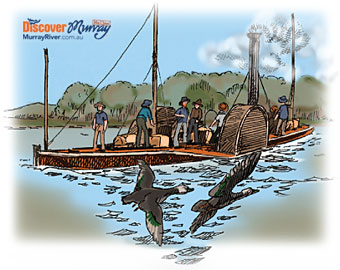 |
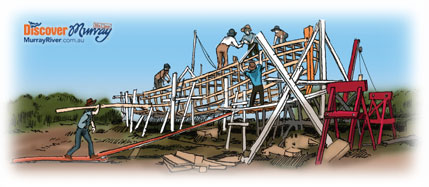 |
Ride on a Murray River paddle steamerThe Mary Ann Boiler
|
Tell your friends you found this at murrayriver.com.au!
Copyright Discover Murray 2025. This site or any portion of this site must not be reproduced, duplicated, copied, sold, resold, or otherwise exploited for any commercial purpose that is not expressly permitted by DISCOVER MURRAY.






 Kevin Bloody Wilson Aussie Icon Tour with special guest Jenny Talia
Kevin Bloody Wilson Aussie Icon Tour with special guest Jenny Talia The Australian Beach Boys Show
The Australian Beach Boys Show Lee Kernaghan Boys From The Bush The Concert
Lee Kernaghan Boys From The Bush The Concert Amy Shark The Solo Acoustic "Songs & Stories" Tour
Amy Shark The Solo Acoustic "Songs & Stories" Tour Little By Little
Little By Little